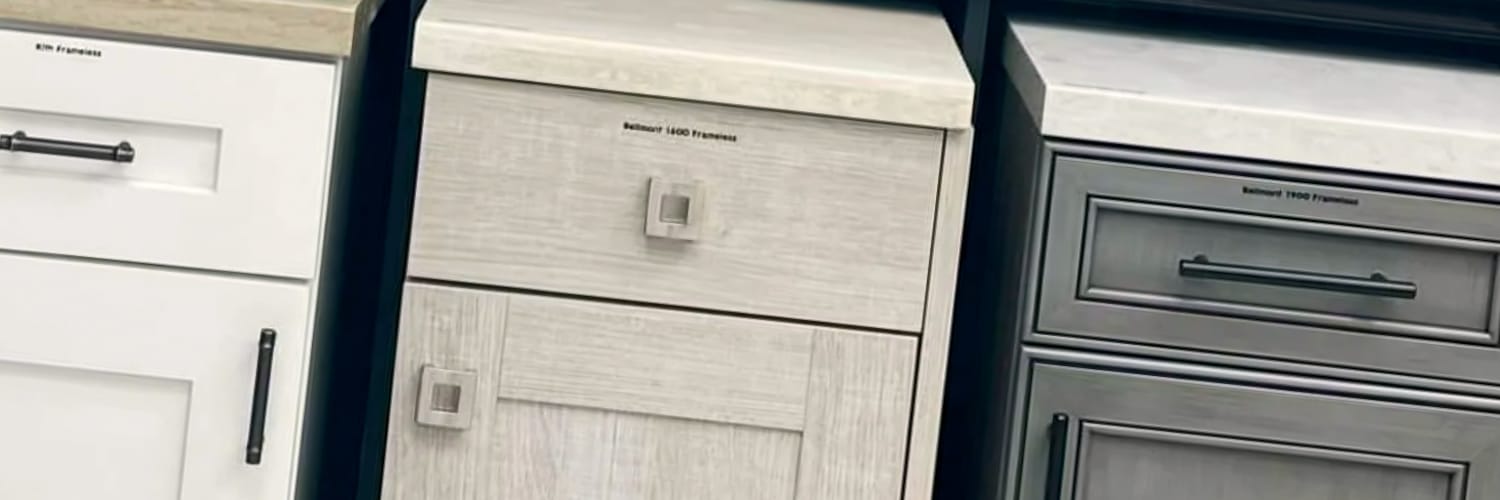“Approach each customer with the idea of helping him or her solve a problem or achieve a goal, not of selling a product or service.”
Imagine today’s consumer wandering around your kitchen and bath showroom. One kitchen display after another is gorgeous. Each mock-up projects a different theme — urban modern, country chic, southwestern warmth, etc — and all found very appealing.
The consumer may become a bit flustered, not sure which direction to go. Can they really afford this kitchen and bath firm? Or should they move onto the next showroom on their visitation list?
But if your sales professional starts engaging them with your company’s comprehensive, educational approach to selling kitchens and baths, they can — and will — afford your firm! That’s what the expert unpacking of a cabinet comparison display will help prove to them. It’s the perfect complementary educational tool to the Good-Better-Best sales process.
Why you should have Good, Better, Best Cabinetry
Customers want choice, but not too much of a choice. Having too many cabinet lines can be counterproductive for a good reason.
First, consider that your firm cannot become important enough to any vendor to make your business command their ongoing attention and support from carrying their line. Another reason is there is so much to learn with each line, that carrying too many of them can lead to ordering mistakes and the hassle involved in reorders.
Stick with three offerings. Doing so sends a message of discernment to your clients and prospects that demonstrates the high standards your firm holds for the products you sell.
While there are thousands of offerings out there, SEN has identified six different grades of cabinetry:
- Local shop-built In many markets, this is the “go-to” cabinet product for local builders because it is cheap and can be produced quickly.
- Production/Ready To Assemble (RTA) Another low cost, builder-favorite that typically have better finishes than what local shops can provide.
- Semi-Custom Provide a greater variety of styling, finishes, and accessories in a better made box than RTA grade — still at a good price point.
- Popular Custom Similar to Semi-Custom except that more modifications to the box are possible.
- Furniture Custom Expands on Popular Custom Grade with most vendors capable of matching special finish requests, offering better consumer literature, and having a broader variety of SKUs for cabinetry applications in other rooms of the house.
- Luxury State-of-the-art, premium construction quality with brands that often advertise on the pages of leading consumer shelter publications.
To choose the product you carry, determine what constitutes each of the three quality grades that best fit your target customers (i.e. remodeling contractor, millennial couple, double income professionals, etc). Then select your cabinet lines from potential vendor partners who offer the best quality at the best comparative price point — which translates into the best value in each of the three quality grades.
As a rule of thumb, separate the rankings by no more than four features per product. This is conventional wisdom when applying G-B-B selling to a business model. In the case of cabinetry, finish quality, drawer box construction, hardware quality, and wood species available are features to take into consideration.
Why a cabinet comparison display is essential
Most prospects aren’t aware of the differences between a base model cabinet and an expensive one. So when looking at showroom displays, they don’t really know the value of the product they are seeing.
By educating prospects on the product in your showroom in the style of the Good-Better-Best interactive selling process, prospective customers can make well-informed decisions.
As unlikely as it may seem, most showrooms don’t have cabinetry display walls. Their showrooms are filled with kitchen displays in different styles with the various product they carry without any effort to demonstrate to the customer the quality of the cabinetry lines carried.
Prospects visiting your showroom might see Good cabinetry offerings in a beautiful display without knowing anything about the product or there being a guide to educate them on it. In such a case, they have no point of comparison to rate against a Better or Best offering. Until product samples are displayed side by side, so the customer can see the materials used to make them, will they be able to understand the differences that justify why they are priced differently.
A skilled sales designer can help the customer see the differences in the construction like the thickness of the sides, how the drawers operate, the clarity and smoothness of finish, and how many adjustments per shelf are possible within the product. When 18” wide sample cabinets are positioned side by side, the customer can see the finish of one product versus another, tell how well the wood has been sanded, and compare and contrast the styles between Good, Better, and Best offerings.
Buying cabinetry is an educative process of a granular nature that helps to build a foundation of trust between the customer and designer. The typical inquisitive customer who learns the budget ranges of your cabinet lines — and understands why your Best quality offering costs a good bit more than your Better and Good offerings, is going to lean in and become increasingly more comfortable in doing business with your firm.
How to properly set up a cabinet comparison display
A typical G-B-B style cabinet display would show the Good cabinet offerings on the left, the Better choices in the middle, and the Best offering on the far right. Signage could be placed in the backsplash area denoting each quality grade and/or their ranking specifications.
Dealers could set their cabinet comparison displays up with each offering in the same species of wood so that customers can better detect the differences in quality and value between them. But more often than not, owners use these cabinet comparison displays as an extended opportunity to show additional door styles and/or finishes from the various cabinet brands they represent.
Educate prospects using your cabinet display wall
When talking to prospects about your firm’s cabinet lines, designers should be unbiased in their approach to educating them on the brands you carry. People like to be informed, not sold.
So designers should be objective in their approach to introducing the brands you carry to prospective customers, enabling them to get all the information they need to make an informed decision for themselves. This approach gives prospects a sense of empowerment. When customers are empowered, they will feel a lot better about committing sooner rather than later. And when customers feel better about the buying process, they are also liable to spend more.
The cabinet lines you carry should be presented as the very best value for each of the grades represented.
Prospects are liable to be turned off by dealers who are who too strongly favor one particular brand or quality grade. Let the product speak for itself. Simply put them in a comparative display, and then have your knowledgeable, experienced designers furnish the valuable education for the prospective clients who come into your showroom.
One danger of showing bias for a product, such as one in the Best category, is that if the prospect is not comfortable with that budget range, they are not going to feel comfortable purchasing one of your Good offerings. They would likely take their business to another firm.
A perfect lead-in to a G-B-B interactive budgeting exercise and getting retained
Be a consultant rather than a salesperson. People don’t want to be sold anything, they want to be informed so that they can make intelligent decisions.
So when you’re sitting down with prospects, in front of a computer with your DesignAlign budgeting system, you can show your prospects what their first, second, and third cabinet preferences look like number-wise for their projected kitchen design concept.
This transparent way of doing business ensures that the prospect is comfortable with the process, and cost of the job, at every step of the way. Their empowerment makes for an easy buy-in for the final budget range, leading to a quick commitment and retainer check.
It’s the designer’s job to deliver the information clearly and accurately. When you create an objective, educative environment for your prospects, they have a firm foundation from which to do business with your firm. When this foundation of trust is in place, a higher percentage of your prospects will turn into loyal clients, buying all future projects from your firm, and become raving fans for your brand.
—The SEN Leadership Team


